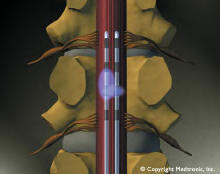|
back
spinal cord stimulators (medtronic - mdt)
 Spinal
cord stimulation (medtronic) has been used for thirty years (introduced in 1967),
to diminish pain in patients. It is extremely beneficial to patients
with certain types of low back and lower extremity pain. Although it's
exact mechanism of operation remains unclear, it appears to work by blocking
transmission of pain fibers. Spinal
cord stimulation (medtronic) has been used for thirty years (introduced in 1967),
to diminish pain in patients. It is extremely beneficial to patients
with certain types of low back and lower extremity pain. Although it's
exact mechanism of operation remains unclear, it appears to work by blocking
transmission of pain fibers.
Spinal cord stimulation (medtronic - mdt) is one of the most
successful techniques available for the treatment of intractable chronic
pain syndromes of benign origin. It is often as good as reoperation
for many patients with failed back syndrome, and for those who have failed
reoperation.
The
procedure is generally done under local anesthesia. Either an
electrode is inserted through an epidural needle, or a limited laminectomy
is done to permit placement of larger epidural (around the spinal cord)
electrodes. Risks of the procedure
are very low, with the major risk being infection (occurs in 5% of cases).

Several of the images on this site have been provided
courtesy of medtronic
- mdt.
Indications for stimulator (medtronic) implantation
- failed back syndrome (persistent pain in patients
who have undergone at least one previous operation; may involve
epidural fibrosis and arachnoiditis)
- more helpful for lower extremity than low back
pain, although both stand to benefit
- 50-60% success rate 5 years after surgery
- reflex sympathetic dystrophy (RSD)
- 70-100% success rate, at 14 to 41 months after
surgery
- post amputation pain (phantom limb pain)
- 68% success rate in one study
- post herpetic neuralgia
- 90% success rate in one study
- spinal cord injury dysesthesias (pain in lower
extremities associated with spinal cord injury)
- pain associated with multiple sclerosis
- peripheral vascular disease (insufficient blood
flow to the lower extremity, causing pain and placing it at risk for
amputation)
- 80% success at avoiding the need for amputation
when the initial implant trial was successful
- documented improvement in blood flow to the
lower extremity when bypass surgery was not indicated
- improvement in lower extremity pain while
walking, in more than 75% of patients with surgically uncorrectable
vascular disease
Generally, the more localized in the periphery the
pain is, the better the results. A unilateral extremity will respond
best to stimulation, but with the design improvements, and the
availability of dual systems and leads with multiple electrodes, it is
possible to treat pain over the spine as well as in both extremities.
spinal cord stimulator (medtronic - mdt) implantation technique
Patient education for
spinal cord stimulation (medtronic mdt)
|

